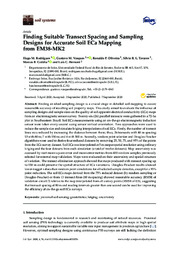Finding suitable transect spacing and sampling designs for accurate soil ECa mapping from EM38-MK2.
Finding suitable transect spacing and sampling designs for accurate soil ECa mapping from EM38-MK2.
Author(s): RODRIGUES, H. M.; VASQUES, G. de M.; OLIVEIRA, R. P. de; TAVARES, S. R. de L.; CEDDIA, M. B.; HERNANI, L. C.
Summary: Finding an ideal sampling design is a crucial stage in detailed soil mapping to assure reasonable accuracy of resulting soil property maps. This study aimed to evaluate the influence of sampling designs and sample sizes on the quality of soil apparent electrical conductivity (ECa) maps from an electromagnetic sensor survey. Twenty-six (26) parallel transects were gathered in a 72-ha plot in Southeastern Brazil. Soil ECa measurements using an on-the-go electromagnetic induction sensor were taken every second using sensor vertical orientation. Two approaches were used to reduce the sample size and simulate kriging interpolations of soil ECa. Firstly, the number of transect lines was reduced by increasing the distance between them; thus, 26 transects with 40 m spacing; 13 with 80 m; 7 with 150 m; and 4 with 300 m. Secondly, random point selection and Douglas-Peucker algorithms were used to derive four reduced datasets by removing 25, 50, 75, and 95% of the points from the ECa survey dataset. Soil ECa was interpolated at 5 m output spatial resolution using ordinary kriging and the four datasets from each simulation (a total of twelve datasets). Map uncertainty was assessed by root mean square error and mean error metrics from 400 random samples previously selected for external map validation. Maps were evaluated on their uncertainty and spatial structure of variation. The transect elimination approach showed that maps produced with transect spacing up to 150 m could preserve the spatial structure of ECa variations. Douglas-Peucker results showed lower nugget values than random point simulations for all selected sample densities, except for a 95% point reduction. The soil ECa maps derived from the 75% reduced dataset (by random sampling or Douglas-Peucker) or from 13 transect lines (80 m spacing) showed reasonable accuracy (RMSE of validation circa 0.7) relative to the map interpolated from all survey points (RMSE of 0.5), suggesting that transect spacing of 80 m and reading intervals greater than one second can be used for improving the efficiency of on-the-go soil ECa surveys.
Publication year: 2020
Types of publication: Journal article
Unit: Embrapa Soils
Observation
Some of Embrapa's publications are published as ePub files. To read them, use or download one of the following free software options to your computer or mobile device. Android: Google Play Books; IOS: iBooks; Windows and Linux: Calibre.
Access other publications
Access the Agricultural Research Database (BDPA) to consult Embrapa's full library collection and records.
Visit Embrapa Bookstore to purchase books and other publications sold by Embrapa.

